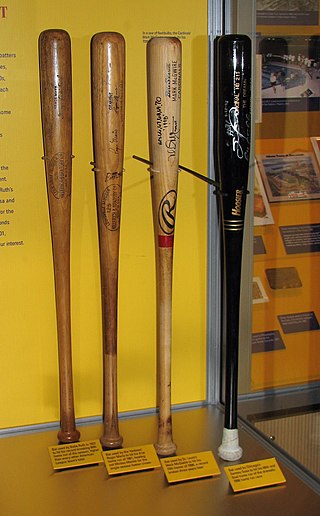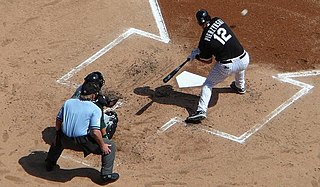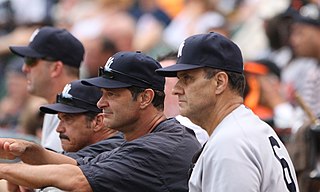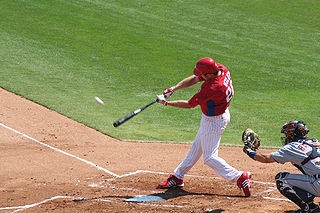Baseball statistics play an important role in evaluating the progress of a player or team.

Softball is a game similar to baseball, and it is played with a larger ball on a smaller field and with only underhand pitches permitted. Softball is played competitively at club levels, the college level, and the professional level. The game was first created in 1887 in Chicago by George Hancock.
In baseball, a corked bat is a specially modified baseball bat that has been filled with cork or other lighter, less dense substances to make the bat lighter. A lighter bat gives a hitter a quicker swing and may improve the hitter's timing. Despite popular belief that corking a bat creates a "trampoline effect" causing a batted ball to travel farther, physics researchers have shown that this is not the case. In Major League Baseball, modifying a bat with foreign substances and using it in play is illegal and subject to ejection and further punishment.

In baseball, the pitcher is the player who throws ("pitches") the baseball from the pitcher's mound toward the catcher to begin each play, with the goal of retiring a batter, who attempts to either make contact with the pitched ball or draw a walk. In the numbering system used to record defensive plays, the pitcher is assigned the number 1. The pitcher is often considered the most important player on the defensive side of the game, and as such is situated at the right end of the defensive spectrum. There are many different types of pitchers, such as the starting pitcher, relief pitcher, middle reliever, lefty specialist, setup man, and the closer.

The fastball is the most common type of pitch thrown by pitchers in baseball and softball. "Power pitchers," such as former American major leaguers Nolan Ryan and Roger Clemens, rely on speed to prevent the ball from being hit and throw fastballs at speeds of 95–105 miles per hour (153–169 km/h) (officially) and up to 108.1 miles per hour (174.0 km/h) (unofficially). Pitchers who throw more slowly can put movement on the ball, or throw it on the outside of home plate where batters cannot easily reach it.

Elston Gene Howard was an American professional baseball player who was a catcher and a left fielder. During a 14-year baseball career, he played in the Negro leagues and Major League Baseball from 1948 through 1968, primarily for the New York Yankees. A 12-time All-Star, he also played for the Kansas City Monarchs and the Boston Red Sox. Howard served on the Yankees' coaching staff from 1969 to 1979.

'Warming up' is a part of stretching and preparation for physical exertion or a performance by exercising or practicing gently beforehand, usually undertaken before a performance or practice. Athletes, singers, actors and others warm up before stressing their muscles. It is widely believed to prepare the muscles for vigorous actions and to prevent muscle cramps and injury due to overexertion.

A baseball bat is a smooth wooden or metal club used in the sport of baseball to hit the ball after it is thrown by the pitcher. By regulation it may be no more than 2.75 inches (7.0 cm) in diameter at the thickest part and no more than 42 inches (1.067 m) in length. Although historically bats approaching 3 pounds (1.4 kg) were swung, today bats of 33 ounces (0.94 kg) are common, topping out at 34 to 36 ounces.

Throughout the history of baseball, the rules have frequently changed as the game continues to evolve. A few common rules most professional leagues have in common is that four balls is a base on balls, three strikes is a strikeout, and three outs end a half-inning.

In baseball, batting is the act of facing the opposing pitcher and trying to produce offense for one's team. A batter or hitter is a person whose turn it is to face the pitcher. The three main goals of batters are to become a baserunner, to drive runners home or to advance runners along the bases for others to drive home, but the techniques and strategies they use to do so vary. Hitting uses a motion that is virtually unique to baseball and its fellow bat-and-ball sports, one that is rarely used in other sports. Hitting is unique because it involves rotating in the horizontal plane of movement, unlike most sports movements which occur in the vertical plane.

Strength training, also known as weight training or resistance training, involves the performance of physical exercises that are designed to improve strength and endurance. It is often associated with the lifting of weights. It can also incorporate a variety of training techniques such as bodyweight exercises, isometrics, and plyometrics.

A checked swing is a type of motion in baseball made by a batter. A checked swing occurs when a batter starts to swing the bat at the ball, but stops the swing in order to allow the ball to pass without hitting it. If the swing was indeed checked, so that there was no swing, and if the bat did not touch the ball and it did not go through the strike zone, the pitch counts as a ball; but in that circumstance if the swing was not checked, so that a swing occurred, then the pitch counts as a strike.
This is an alphabetical list of selected unofficial and specialized terms, phrases, and other jargon used in baseball, along with their definitions, including illustrative examples for many entries.

Ballistic training, also known as compensatory acceleration training, uses exercises which accelerate a force through the entire range of motion. It is a form of power training which can involve throwing weights, jumping with weights, or swinging weights in order to increase explosive power. The intention in ballistic exercises is to maximise the acceleration phase of an object's movement and minimise the deceleration phase. For instance, throwing a medicine ball maximises the acceleration of the ball. This can be contrasted with a standard weight training exercise where there would be a pronounced deceleration phase at the end of the repetition i.e. at the end of a bench press exercise the barbell is decelerated and brought to a halt. Similarly, an athlete jumping whilst holding a trap bar maximises the acceleration of the weight through the process of holding it whilst they jump- where as they would decelerate it at the end of a standard trap bar deadlift.

In baseball, a number of coaches assist in the smooth functioning of a team. They are assistants to the manager, who determines the starting lineup and batting order, decides how to substitute players during the game, and makes strategy decisions. Beyond the manager, more than a half dozen coaches may assist the manager in running the team. Essentially, baseball coaches are analogous to assistant coaches in other sports, as the baseball manager is to the head coach.

David JohnLeMahieu is an American professional baseball infielder for the New York Yankees of Major League Baseball (MLB). He previously played for the Chicago Cubs and Colorado Rockies.
Composite baseball bats, opposed to aluminum or wood baseball bats, incorporate a reinforced carbon fiber polymer, or composite, into the bat's construction. This composite material can make up all or part of the bat. Bats made entirely of this polymer are referred to as composite bats. Bats which only incorporate a portion of polymer are referred to as composite hybrids.

On October 8, 1956, in Game 5 of the 1956 World Series, pitcher Don Larsen of the New York Yankees threw a perfect game against the Brooklyn Dodgers at Yankee Stadium. It was the only no-hitter in World Series history until the Houston Astros pitching staff of Cristian Javier, Bryan Abreu, Rafael Montero and Ryan Pressly threw a combined no-hitter in the 2022 World Series against the Philadelphia Phillies. It remains the only perfect game in the history of the World Series.

In baseball, hitting mechanics studies the biomechanical motion that governs the swing of a baseball player. The goal of biomechanics in hitting during baseball training is to study and improve upon the physics involved in hitting. This includes optimizing a player's swing for either maximizing their "bat speed" or time for plate coverage. There is a wide range of batting stances and mechanics that are developed through individual preferences. However, when comparing among experienced baseball players, their batting mechanics approach are almost similar.

















